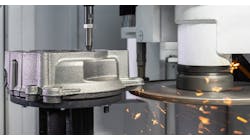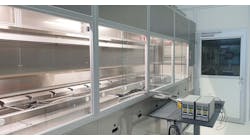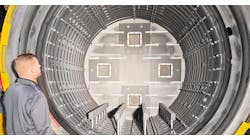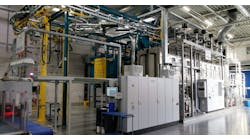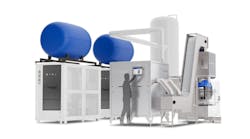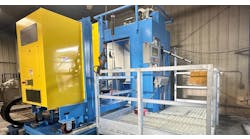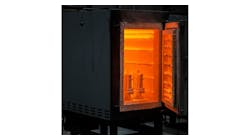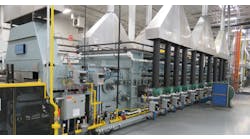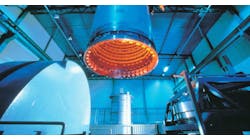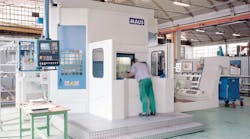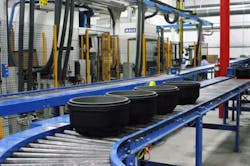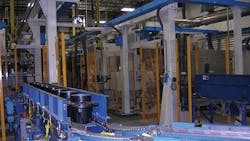Latest from Finishing
Numerous dimensions of manufacturing technology are converging for today’s machine shops — and the foundries that are adopting machining to make their operations more attractive to casting buyers.
Webb Wheel Products Inc. has a 100,000-sq. ft. plant in Tell City, IN, where it machines ductile and gray iron castings into brake drums and hubs for the heavy-duty trailer market. The core of operation is a series of 16 Maus machining centers for turning, drilling, grinding and marking products. Maus is an Italian machine builder of surface grinding systems, transfer lines and vertical turning lathes.
Maus vertical lathes are built as single-station, dedicated operation machines, intermediate work cells, and turnkey production lines, and the builder uses Siemens controls on all the machines it builds.
Webb Wheel produces 400 varieties of cast brake drums, in sizes from 12.25 x 6.00 in. to 18.00 x 8.00 in.; both vented and ribbed transit drums; BTS (Brake Turbine System) drums up to 16.50 x 8.62 in., for use with Lynnfin brake turbines; trailer, drive and steering axle hubs; standard and ABS rotors, plus spoke wheels of many types.
David Link, v.p. - Manufacturing, said the process of designing the plant emphasized total control of the overall machining process. Also, Webb Wheel uses a custom material handling system that needed to be linked to the machining center control panels, for integrated part movement.
All the Maus machining cells are controlled by Siemens Sinumerik 840D CNCs, where each is used to monitor axis movement, spindle movement, rotary table positions, transfer lines, ancillary robotics, CMM probing and laser detection orientations. The 840D offers a range of CNC functions for milling, drilling, turning, grinding, and material handling. Its control capabilities also include nibbling, punching, and laser-machining processes.
Several features of Sinumerik 840D increase productivity on the manufacturing floor, especially the challenging segments of high-speed and five-axis machining. These features include the ability to assign various axes and spindles to one CNC in sequence and link to multiple inline operator panels. Also, a Windows XP or NT operating system can be used, and the CNC can run ancillary robotics, transfer lines, even unattended, lights-out mode laser detection devices.
Cellular activity
Each of Webb Wheel’s machining cells can be programmed with the entire work cycle program for the particular hub or brake drum being produced, sequentially. When a changeover is required, the process has advantages in time and movement efficiencies, as Sandra Selwan, marketing manager for Maus, explained. “When we change production on the cell, we simply create screens for the operator. On these screens, the operator can answer ‘yes’ or ‘no,’ in most cases. The standard program on the Siemens CNC interprets the answers and predisposes the cell for the new part.”
David Link called attention to the CNC’s remote controller used. “The Siemens HT6 handheld device allows the operator to interact with the host control panel from various locations on the cell. This is extremely helpful.”
Webb uses both the Maus MTV high-volume machining cells and the Maus MTC vertical turning centers with 36-position tool changers, for its hub and brake drum production. Reportedly, this gives the Tell City plant great flexibility and reduces its response times for special orders.
“The large, user-friendly control panels are a real plus for our operators,” Link commented. “The Sinumerik 840D gives us great versatility for advanced programming right at the control, and the large memory capacity is ideal for managing the multi-function work cells, especially. We use a gantry system to move product from one operation to the next in our work cell. The Siemens CNCs are controlling and calculating the functions of both the work cells and the material handling system.”
He added that the end-user support Webb Wheel received onsite from Siemens in their training classes “has proven very instrumental in the development of our Tell City workforce.” Webb Wheel uses other controls on the machining cells and work centers in its other facilities, but chose Siemens, after a thorough review, done in partnership with Maus.
